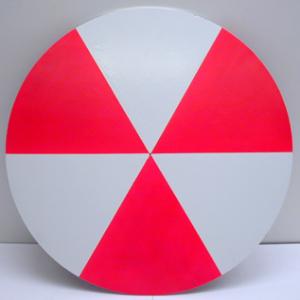College of Liberal Arts & Sciences
1A50.10 - Radian Disk
The radian disk can be used in several ways. One way is to measure the radius and compare them to the outer arc. Note that when you measure the radius along the outer circumference of the circle you will get 3 equal areas plus that pesky .14 slice ( pi = 3.14 ) for each 180 degrees of the circle ( The entire circle is 2pi radians ). You can compare this to the other disk that just has 6 equal areas.
The disks can also be set on the screwdriver shaft through the hole in the middle so that it may be set up in a vertical fashion for easy turning.
The equilateral triangle arc can be used to show the radian angle is less than 60 degrees. By making one of the sides into an arc you have to compress the two other sides so that the angle is less than 60 degrees. This triangle is designed to be used with our radian disk.
- Tim Williamson, "Author's Response", TPT, Vol. 52, # 2, Feb. 2014, p. 68.
- Donald E. Simanek, "The Measure of Pi", TPT, Vol. 52, # 2, Feb. 2014, p. 68.
- Timothy Williamson, "Calculating Pi Using the Monte Carlo Method", TPT, Vol. 51, # 8, Nov. 2013, p. 468.
- Terrence P. Toepker, "Physics and Pizza Circles", TPT, Vol. 49, # 7, Oct. 2011, p. 404.
- Thomas B. Greenslade Jr., "The Area of a Circle", TPT, Vol. 49, # 3, March 2011, p. 160.
- "Figuring Physics", TPT, Vol. 48, # 7, Oct. 2010, p. 441.
- Claudio Guerra-Vela, "Pi from a Milk Container", TPT, Vol. 37, #4, Apr. 1999, p. 246.
- Mel Buchanan, Mark Graham, and Tom Hunter, "A Nostalgic Demonstration of the Radian", TPT, Vol. 37, # 4, p. 253, April 1999.
- Robert C. Hilborn, "Puzzle Solved", TPT, Vol. 34, # 1, Jan. 1996, p. 69.
- John M. McKinley, "The Mil and the Military", TPT, Vol. 34, # 4, Apr. 1996, p. 197.
- Robert A. Morse, "Whence the "Grade"", TPT, Vol. 33, # 2, p. 70, Feb. 1995.
- Robert J. Whitaker, "Whence the "Radian"?", TPT, Vol. 34, # 7, Oct. 1994, p. 444.
- Gordon J, Aubrecht, II, Anthony P. French, Mario Iona, and Daniel W. Welch, "The Radian - That Troublesome Unit", TPT, Vol. 31, # 2, Feb. 1993, p. 84.
- E. S. Oberhofer, "r-r-r!", TPT, Vol. 31, # 4, Apr. 1993, p. 196.
- Bruce L. Scott, "It's Obvious - Now", TPT, Vol. 31, # 5, May 1993, p. 262.
- E. S. Oberhofer, "What Happens to the "Radians"?", TPT, Vol. 30, # 3, p. 170, March 1992.
- Anthony P. French, "What Happens to the "Radians"?", TPT, Vol. 30, # 5, p. 260, May 1992.
- M-16a, Wallace A. Hilton, Physics Demonstration Experiments."
Disclaimer: These demonstrations are provided only for illustrative use by persons affiliated with The University of Iowa and only under the direction of a trained instructor or physicist. The University of Iowa is not responsible for demonstrations performed by those using their own equipment or who choose to use this reference material for their own purpose. The demonstrations included here are within the public domain and can be found in materials contained in libraries, bookstores, and through electronic sources. Performing all or any portion of any of these demonstrations, with or without revisions not depicted here entails inherent risks. These risks include, without limitation, bodily injury (and possibly death), including risks to health that may be temporary or permanent and that may exacerbate a pre-existing medical condition; and property loss or damage. Anyone performing any part of these demonstrations, even with revisions, knowingly and voluntarily assumes all risks associated with them.
